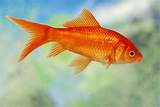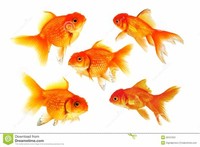Facts about Goldfish

Conversely, temperatures over 25 °C (77 °F) can be extremely damaging for goldfish and is the main reason why tropical tanks are not desirable environments.

Without some form of population control, goldfish ponds can easily become overstocked.

Goldfish are usually classified as a coldwater fish and can live in unheated aquariums.

In 1611, goldfish were introduced to Portugal and from there to other parts of Europe (BAS 2007).
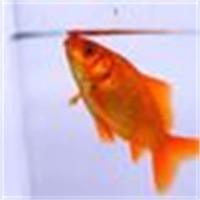
Sudden changes in water temperature can be fatal to any fish, including the goldfish.

Behavior can vary widely both because goldfish are housed in a variety of environments, and because their behavior can be conditioned by their owners.

After being kept in a tank for several weeks, it becomes possible to feed a goldfish by hand without it reacting in a frightened manner.

The true lifespan of a well-cared-for goldfish in captivity can extend beyond 10 years.

Others hold that the wild form of the goldfish (Carassius auratus auratus) is Carassius auratus gibelio, or rather Carassius gibelio with auratus as the subspecies.

Goldfish have behaviors, both as groups and as individuals, that stem from native carp behavior.

Research has demonstrated that goldfish have a memory-span of at least three months and can distinguish between different shapes, colors and sounds (Henderson 2003).

Goldfish that have constant visual contact with humans also seem to stop associating them as a threat.

Small to large ponds are fine for keeping goldfish, although the depth should be at least 80 centimeters (30 inches) to avoid freezing.
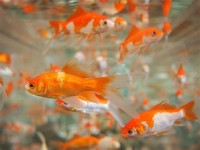
Pet goldfish, as with many other fish, will usually eat more food than it needs if given, which can lead to fatal intestinal blockage.

Many sources claim that crucian carp (Carassius carassius) is the wild version of the goldfish.
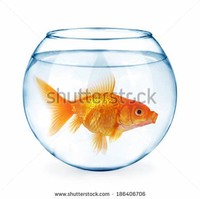
Goldfish are popular pond fish, since they are small, inexpensive, colorful, and very hardy.

Auditory responses from a blind goldfish proved that it recognized one particular family member and a friend by voice, or vibration of sound.

A goldfish will need a lot more time, perhaps days or weeks, to adjust to such a different temperature.

Around the sixteenth century or beginning of the seventeenth century, goldfish were introduced to Japan (BAS 2007), where the Ryukin and Tosakin varieties were developed.

Some extreme versions of the goldfish need to be kept in an aquarium—they are much less hardy than varieties closer to the "wild" original.

Over time, goldfish should learn to associate their owners and other humans with food, often “begging” for food whenever their owners approach.
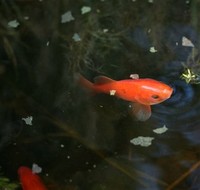
During winter, goldfish will become sluggish, stop eating, and often stay on the bottom.
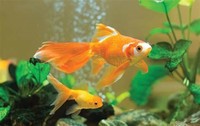
One of the earliest fish to be domesticated—in China over 1,000 years ago (BAS 2007)—the goldfish remains one of the most popular aquarium fish.

By this time, people outside the royal family were forbidden to keep goldfish of the gold (yellow) variety, yellow being the royal color.

Scientific studies done on the matter have shown that goldfish have strong associative learning abilities, as well as social learning skills.

The first occurrence of fancy tailed goldfish was recorded in the Ming dynasty.

Goldfish may be coldwater fish, but this does not mean they can tolerate rapid changes in temperature.

Some scientists believe goldfish can only grow to sexual maturity if given enough water and the right nutrition.

A relatively small member of the Cyprinidae family, the goldfish is a domesticated version of a dark-gray/brown carp native to East Asia.

Goldingham mainly described art, statues, and inscriptions found throughout the archaeological site at Mahabalipuram.

Common and comet goldfish can survive, and even thrive, in any climate in which a pond for them can be created.

Most goldfish can and will breed if left to themselves, particularly in pond settings.

A common belief that goldfish have a three-second memory has been proven false (Henderson 2003).

The only real threat that goldfish present to each other is in food competition.

The longest goldfish was measured at 47.4 cm (18.7 in) from snout to tail-fin end on March 24, 2003 in Hapert, The Netherlands (Guinness 2003).

So if a goldfish is kept in the dark it will appear lighter in the morning, and over a long period of time will lose its color.

The sudden shift in temperature—for example at night in an office building where a goldfish might be kept in a small office tank—could kill them.

Goldfish natively live in ponds, and other still or slow moving bodies of water in depths up to 20 meters (65 feet).

Goldfish may also lose their "golden" color, or rather any goldfish color, by being kept in a dark room.

Goldingham mainly described art, statues, and inscriptions found throughout the archaeological site at Mahabalipuram.

The supposed reputation of goldfish dying quickly is often due to poor care among uninformed buyers looking for a cheap pet.
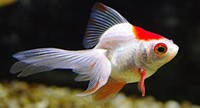
Goldfish may display similar behaviors when responding to their reflections in a mirror.

Like most carp, goldfish produce a large amount of waste both in their feces and through their gills, releasing harmful chemicals into the water.

Due to the strange shapes of some extreme modern bred goldfish, certain types can no longer breed among themselves.

Goldfish, Carassius auratus, may grow to a maximum length of 23 inches (59 cm) and a maximum weight of 9.9 pounds (4.5 kg), although this is rare; few goldfish reach even half this size.

In Chinese goldfish keeping, goldfish are classified into 4 main types, which are not commonly used in the west.
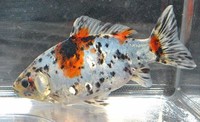
Common goldfish, London and Bristol shubunkins, jikin, wakin, comet, and sometimes fantail can be kept in a pond all year round in temperate and subtropical climates.

Particularly well-known species include the common carp and koi (Cyprinus carpio), goldfish (Carassius auratus), and zebra danio or zebrafish (Brachydanio rerio), the latter used extensively in genetic research (Nelson 1994).
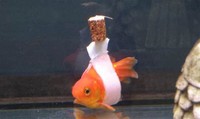
When found in nature, goldfish are actually an olive green, greenish brown, or grayish color.
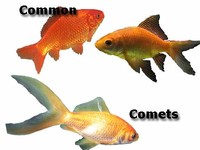
Common and comet goldfish can survive, and even thrive, in any climate in which a pond for them can be created.





